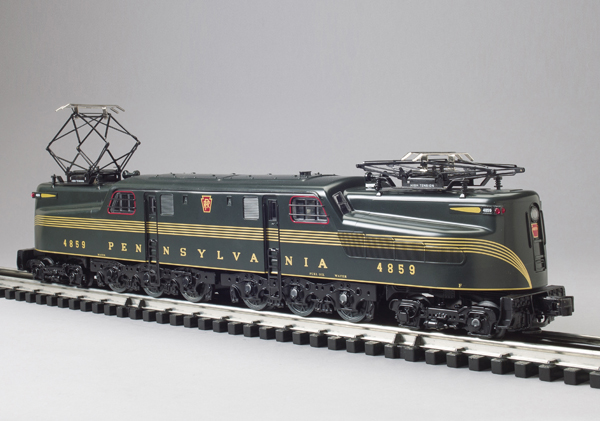Price: $699.95 (no. 20-3546-1) Min Curve: O-42 Cmd Low: N/A Cnv Low: 8.9 smph High: 73.5 smph Drawbar pull: 1 lb., 12 oz. Features: Plastic shell, die-cast metal trucks, two can-style motors, True Blast Plus sound system, operating couplers. Current production road names: Pennsylvania RR green five-stripe, Tuscan five-stripe, silver single-stripe, and Tuscan single-stirpe.
The real GG1 looked totally unlike most of its predecessors. Its streamlined curves and stylish paint scheme were the talk of the town.
The Pennsylvania RR began research into a locomotive to replace the P5a electric in 1933. The railroad desired more power than a P5a with a lighter axle load, but also streamlining and a single control cab (versus a cab on each end of the locomotive) and a top speed of 100 mph.
Both General Electric and Westinghouse were asked to design prototypes for consideration. The GE version beat the Westinghouse version after 10 weeks in service between New York and Philadelphia.
Between 1934 and 1943, 139 of the 4,600-horsepower locomotives were built. Over their operational life they wore the liveries of the Pennsylvania RR, Penn Central, Conrail, Amtrak, and NJ transit. The last left service in 1983, and 16 of the venerable electrics survived, (most are on display).
Opening the box
In a world dominated by semi-scale traditional-size O gauge models, the Williams model stands out. The coupler-to-coupler length is 79 feet in scale while the prototype was 79 feet, 6 inches long. Most traditionally-sized GG1s that I’ve taken a tape measure to came out to about 56 feet in scale, so the model looks impressive right out of the box.
Something to note first: The pantographs and insulators need to be installed. This took just a few minutes to set up, then maybe another 60 seconds to set up correctly (fumble-fingered as always, one of my pantographs wasn’t on snugly and popped off).
This isn’t a Reader’s Digest condensed version of the GG1. The length of the model sets it out from the traditional version, in my opinion, simply because there is greater length for the noses of the locomotive to develop, particularly with a more graceful elevation up to the cab windows. You see the artful industrial design of the body as it was intended.
The die-cast metal pilot is basic and has cast-in brake and multiple-unit lines as well as cast-in receptacles.
The shell is plastic and the ends have cast-in doors with a porthole. A keystone with the engine number is just below the window. Add-on grab irons bracket the door. At the foot of the entry is a representation of a drawbridge for connecting to another GG1.
Looking straight at the GG1 you can see the beautiful curves that make this locomotive design unique. The curvature extends horizontally around the sides and vertically to the cab windows and again up and over the roof.
The smooth, flowing look is interrupted only by the intakes on the engineer’s side, the classification lights on the corners of the nose, and, of course, the pantographs up top.
The sides have add-on steps and grab irons, and the windows all have plastic panes. The side windows have twin safety bars (to stop thrown objects), while the forward windows have a single bar cast into the pane. There are vents cast into the sides, next to the cab doors.
The roof is smooth and with appropriate rivet detail. There is a horn behind each pantograph.
The model has a metal frame, and the trucks are die-cast metal. The trucks capture the spirit of vintage locomotive design – they look heavy and have lots of holes.
There is good brake shoe detailing on them, and they ride on what appears to be spoked wheels – so very steam era!
The green body with gold striping and lettering looks great. It is easy to see this GG1 pulling The Broadway Limited.
The only gap in coloring I noticed was a spot where one of the stripes was going up and over the lip of an air intake, and I had to look pretty hard to find that! The Pennsy keystone with the entwined PRR looks as magical today as it was the first time I noted it, 55 or so years ago.
The Williams GG1 is decked out in formalwear suitable for your finest train.
On the test track
The GG1 has a True Blast Plus sound system that replicates electric motor sounds as well as horn and bell tones.
This is, of course, a conventional-only locomotive. It isn’t equipped with Lionel’s TrainMaster or Legacy command system or MTH’s ProtoSound command system, so expect higher starting speeds.
This model requires O-42 curves for operation and we ran it through O-48 curves. Even at that, there is quite a bit of overhang as the model swings through the curves. Make the first trip around your layout a slow one while you check for trackside obstacles you may hit!
I have noted in many previous reviews that sound systems on electric locomotives are about as noisy as an electrical transformer, and this is no reception. Sound volume was good, but once the train got rolling, it was pretty well overcome by the noise of the rails. The bell and horn, however, were distinct.
Performance was very good, with a low-speed average of 8.9 scale miles per hour and a high-speed average of 73.5 scale miles per hour. Drawbar pull was 1 pound, 12 ounces.
The GG1 was responsive to commands and was swift to increase or lower speeds. All in all, it was a very nicely operating locomotive.
The scale-sized GG1 locomotive from Williams by Bachmann looks terrific and will do well hauling your freight or passenger traffic. If you have ever wanted a GG1, but didn’t like the stubby look of a traditional version, the size and grace of the Williams GG1 may be what you are looking for.














